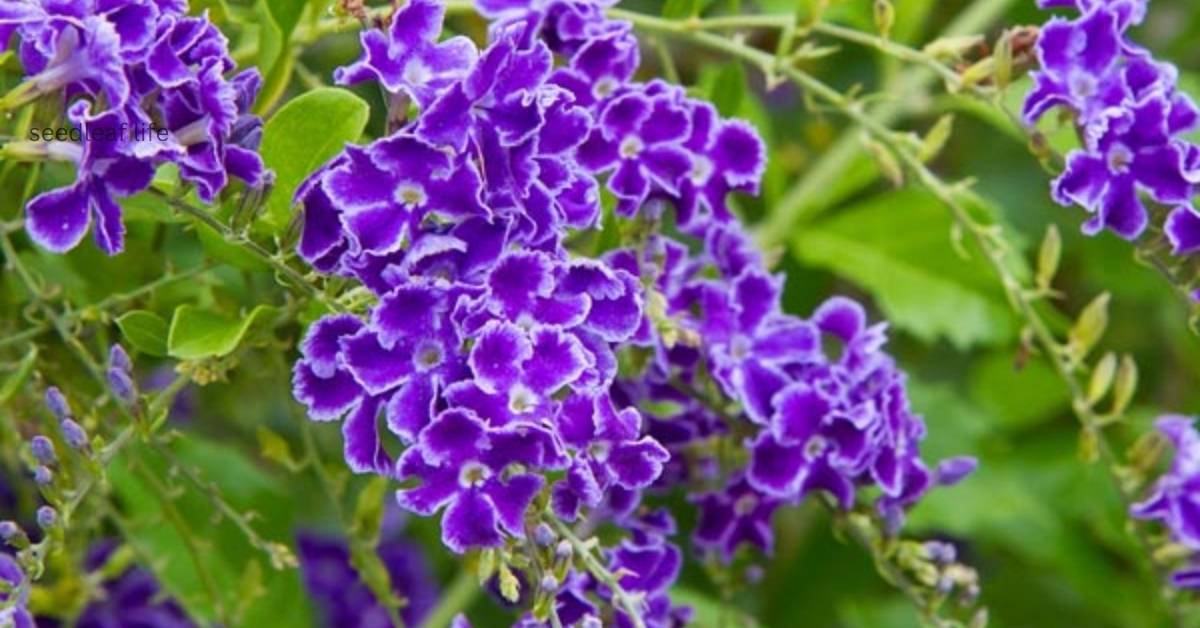The Sky Flower Plant (Duranta erecta), often admired for its cascading clusters of violet-blue flowers and striking golden berries, is one of the most eye-catching ornamental shrubs in the world.
Belonging to the verbena family, this tropical beauty is grown widely across Asia, the Americas, and Australia, making it a popular choice for both home gardens and large landscapes. Gardeners love the Sky Flower Plant not only for its vibrant color contrast but also for its versatility—it can be shaped into hedges, grown as a decorative shrub, or allowed to trail gracefully as a natural screen.
Beyond its beauty, this plant also attracts butterflies and bees, bringing life and movement to any outdoor space. With its fast growth, year-round greenery, and relatively easy care, it’s no surprise that the Sky Flower Plant has become a favorite among garden enthusiasts worldwide. If you enjoy tropical flowering plants, you may also like our Dipladenia Planting Guide, which features another stunning ornamental shrub
What Is Sky Flower Plant?
The Sky Flower Plant, scientifically known as Duranta erecta, is a tropical and subtropical shrub celebrated for its beauty and adaptability. Over the years, it has earned several common names, including Golden Dewdrop, Pigeon Berry, and simply Duranta. Each name reflects a unique feature of the plant—its golden fruits, popularity with birds, or its elegant ornamental appearance.
This plant is a fast-growing evergreen shrub that can reach up to 6–18 feet in height, depending on the climate and care it receives. Its most striking features are the clusters of delicate violet-blue or lavender flowers, often edged in white, that bloom in abundance throughout the warmer months. After flowering, the plant produces small, round golden-yellow berries that add another layer of ornamental value—though they are toxic to humans and pets.
Thanks to its lush green foliage, colorful flowers, and eye-catching fruits, the Sky Flower Plant has become a gardener’s favorite for landscaping, hedging, and decorative planting. It’s not just a plant—it’s a statement of beauty and elegance in any garden or outdoor space.
Appearance and Characteristics of Sky Flower Plant
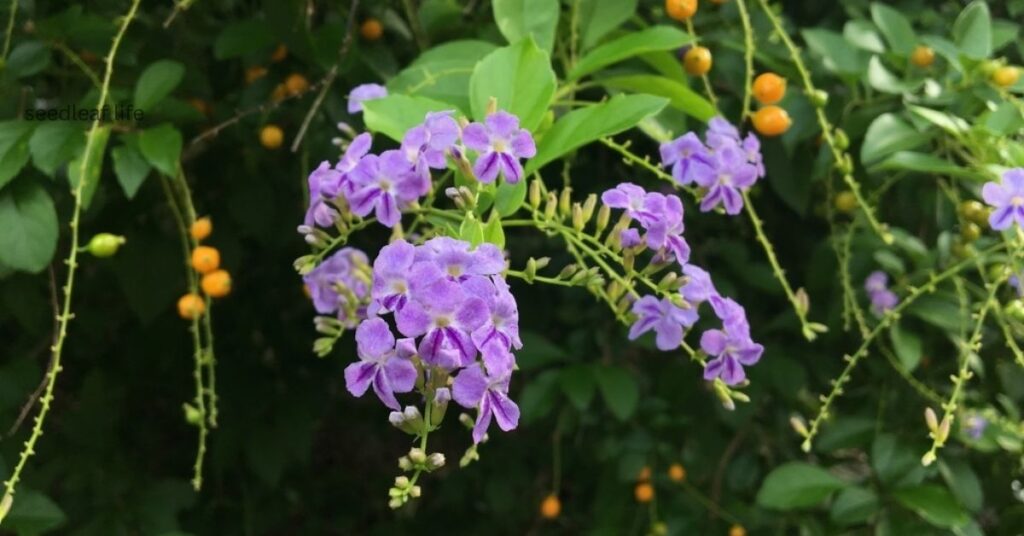
The Sky Flower Plant (Duranta erecta) is admired for its dense green foliage, cascading violet-blue flowers, and shiny golden berries that make it stand out in any garden. Known for its fast growth and ornamental value, this shrub combines beauty with versatility. Its features make it a favorite among gardeners and landscapers worldwide.
Flower Color and Seasonal Blooms
- Produces clusters of violet-blue or lavender flowers.
- Many blooms have a white edging, adding contrast.
- Flowers grow in hanging clusters, creating a waterfall effect.
- Main blooming season: spring through late summer.
- Flowers are small but abundant, covering the shrub.
- Emit a light, pleasant fragrance.
- Highly attractive to bees, butterflies, and other pollinators.
- Add vibrant color and freshness to gardens.
Golden Fruits: Attractive but Toxic
- Develop golden-yellow berries after flowering.
- Fruits are small, round, and shiny.
- Known as Golden Dewdrop due to their appearance.
- Fruits stay on the plant for long periods.
- Provide a striking contrast with green leaves.
- Toxic to humans and pets if consumed.
- Birds are often drawn to these fruits.
- Add ornamental value year-round, even when flowers fade.
Growth Pattern and Lifespan
- A fast-growing, evergreen shrub.
- Can reach 6–18 feet tall depending on conditions.
- Usually spreads 6–10 feet wide.
- Dense, bushy growth makes it great for hedges.
- Has a long lifespan with proper care.
- Can be shaped into hedges, screens, or topiaries.
- Offers year-round greenery.
- Useful as a natural privacy screen.
Wildlife Attraction (Butterflies, Bees, Birds)
- Flowers provide nectar for bees.
- Highly attractive to butterflies.
- Golden berries draw various bird species.
- Increases garden biodiversity.
- Supports a healthy ecosystem.
- Adds movement, sound, and life to outdoor spaces.
- Works as a pollinator-friendly plant.
- Creates a vibrant, lively garden atmosphere.
Benefits of Growing Sky Flower Plant
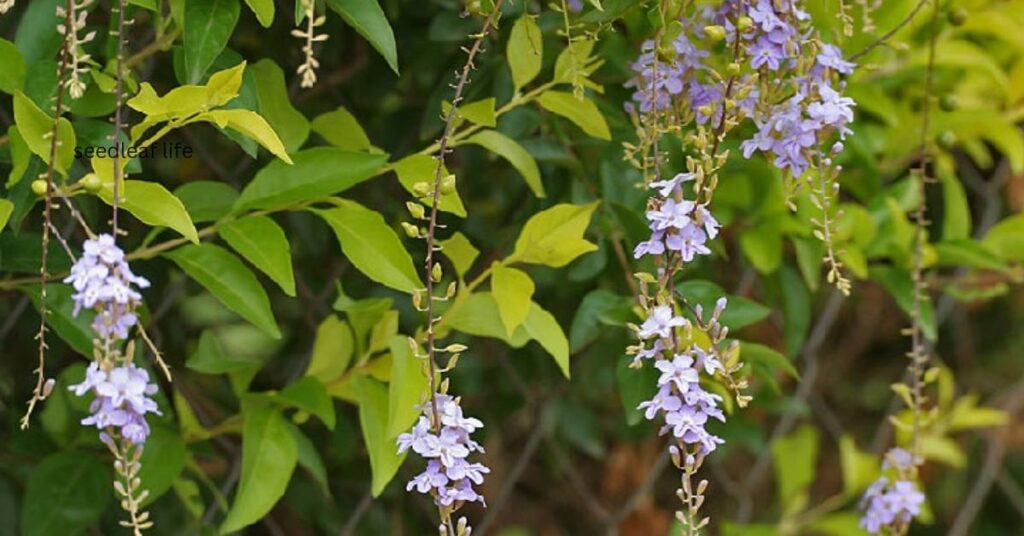
The Sky Flower Plant (Dur anta erecta) is not just admired for its looks but also valued for the benefits it brings to gardens and outdoor spaces. From boosting aesthetic appeal to supporting biodiversity, it provides multiple reasons for gardeners to choose it over other ornamental shrubs. Its versatility and ecological impact make it more than just a decorative plant.
Enhancing Garden Beauty
- Adds vibrant violet-blue blooms that brighten up any landscape.
- Golden berries provide year-round ornamental charm.
- Creates an elegant contrast between flowers, fruits, and foliage.
- Cascading growth pattern brings a graceful, natural flow.
- Works well as a centerpiece in decorative gardens.
- Blends easily with other flowering plants for variety.
- Brings seasonal interest through alternating flowers and berries.
- Elevates the overall design and visual harmony of outdoor spaces.
Natural Hedge and Privacy Screen
- Dense foliage makes it an excellent living fence.
- Provides natural screening for privacy.
- Reduces noise and wind when planted in rows.
- Can be shaped into hedges or decorative borders.
- Offers a greener, eco-friendly alternative to artificial fencing.
- Grows quickly, filling empty spaces in the garden.
- Works well along property lines or walkways.
- Adds both function and charm to landscape design.
Environmental and Ecological Value
- Flowers attract pollinators, supporting bee populations.
- Serves as a nectar source for butterflies.
- Berries invite birds, increasing garden biodiversity.
- Contributes to a healthier local ecosystem.
- Provides shelter for small insects and creatures.
- Enhances air quality through constant greenery.
- Helps maintain soil health by reducing erosion.
- Promotes natural balance in both urban and rural gardens.
How to Plant and Grow Sky Flower Plant at Home
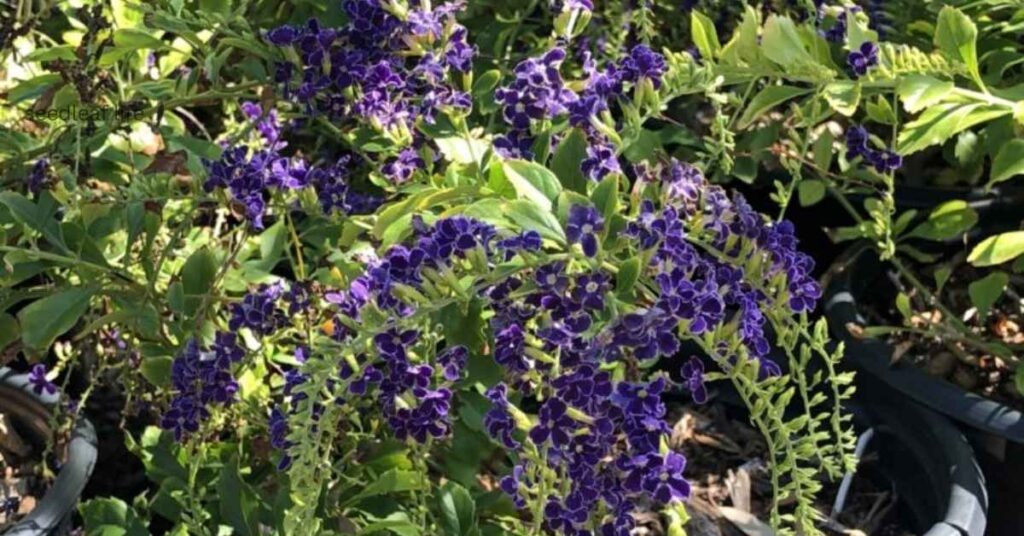
Growing the Sky Flower Plant (Duranta erecta) at home is easier than many gardeners think. This ornamental shrub adapts well to different conditions, making it suitable for both container gardening and open landscapes. With the right soil, planting method, and care, the Golden Dewdrop can thrive and add long-lasting charm to your outdoor area.
Best Soil for Sky Flower Plant
- Prefers well-drained loamy soil for steady growth.
- Can tolerate sandy or slightly clay-rich soils.
- Works well in soil with a pH between 6.0–7.5.
- Adding organic compost improves fertility.
- Loose soil supports strong root development.
- Mulching helps maintain soil moisture.
- Avoid waterlogged ground as it harms roots.
- Regular soil conditioning improves plant longevity.
Planting from Seeds vs. Cuttings
- Propagation possible by both seeds and stem cuttings.
- Seeds take longer and need patience to germinate.
- Cuttings establish more quickly in most conditions.
- Semi-hardwood stems are ideal for propagation.
- Use rooting hormone for better success rates.
- Place cuttings in moist soil until roots form.
- Seeds should be sown in warm, shaded areas.
- Cuttings give a more predictable plant shape.
Container Planting vs. Garden Planting
- Can grow successfully in pots or directly in soil.
- Containers allow easy relocation in changing climates.
- Ideal for balconies, patios, or small urban gardens.
- Outdoor planting gives more space for height and spread.
- Potted plants need regular watering and fertilizing.
- Ground planting requires less frequent care once settled.
- Container-grown shrubs can be shaped easily.
- In open landscapes, they act as natural hedges or borders.
Ideal Climate and Growing Conditions for Sky Flower Plant
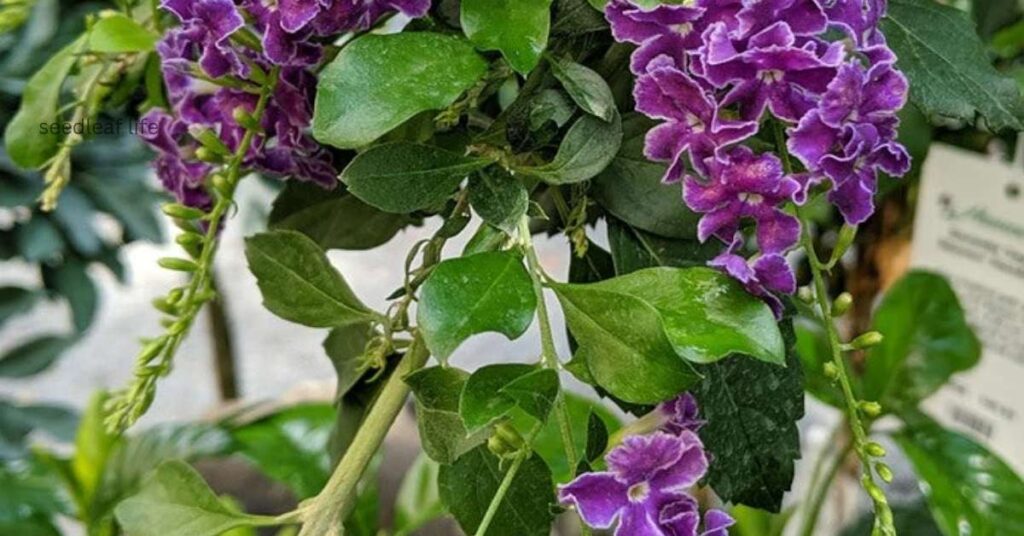
The Sky Flower Plant (Duranta erecta) flourishes in warm, tropical, and subtropical regions. As a hardy ornamental shrub, it adapts to different garden styles but performs best when its climate and care needs are met. By providing the right mix of light, water, and nutrients, this Golden Dewdrop plant remains healthy and visually stunning throughout the year.
Sunlight and Temperature Needs
- Requires full sun exposure for maximum blooming.
- Can tolerate partial shade but produces fewer flowers.
- Thrives in tropical and subtropical temperatures.
- Ideal temperature range: 20°C–32°C (68°F–90°F).
- Sensitive to frost and extreme cold conditions.
- Should be protected during harsh winters.
- Grows best in warm, humid environments.
- Heat-tolerant once fully established.
Watering Schedule and Drainage
- Needs consistent moisture during early growth stages.
- Mature plants tolerate short dry spells.
- Overwatering can cause root rot.
- Soil should stay moist but never soggy.
- Well-draining soil mix prevents waterlogging.
- Water deeply rather than frequent light watering.
- Reduce watering during rainy seasons.
- Mulching helps retain ground moisture effectively.
Fertilizer and Nutrient Requirements
- Benefits from a balanced fertilizer every 4–6 weeks.
- Use a formula rich in phosphorus and potassium for flowers.
- Nitrogen supports dense foliage growth.
- Organic compost improves soil fertility naturally.
- Slow-release fertilizer works well for long-term feeding.
- Avoid excessive feeding, which may harm roots.
- Apply liquid feed during the blooming season.
- Supplement with micronutrients for vibrant growth.
Pruning, Shaping, and Propagation of Sky Flower Plant
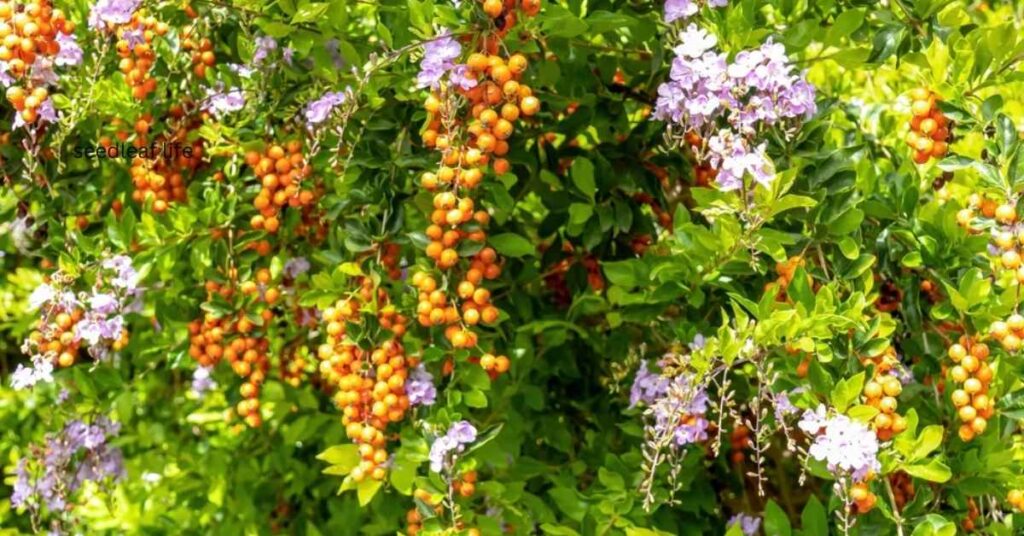
The Sky Flower Plant (Duranta erecta) responds very well to trimming and training, making it a versatile option for creative gardening. With the right pruning, it stays healthy, encourages new growth, and maintains an attractive form. Whether grown as a hedge, a decorative border, or a free-flowing shrub, proper shaping and propagation ensure long-lasting beauty in your garden.
How to Prune for Shape and Health
- Best time to prune is late winter or early spring.
- Remove dead or weak branches to promote vigor.
- Regular trimming keeps the plant compact and tidy.
- Cutting back encourages fresh shoots and more blooms.
- Thin crowded stems for better air circulation.
- Avoid heavy pruning during the flowering season.
- Use sterilized tools to prevent plant diseases.
- Light trimming every few weeks maintains balance.
Popular Shapes for Landscaping
- Can be trained into formal hedges.
- Works well as a rounded ornamental bush.
- Shaped into archways or natural screens.
- Styled into topiary designs for gardens.
- Left untrimmed for a flowing, cascading look.
- Suitable for container shaping on patios.
- Ideal for geometric borders in landscapes.
- Adaptable to both modern and traditional garden styles.
Propagation Methods (Cuttings, Seeds, Layering)
- Stem cuttings are the quickest way to propagate.
- Semi-hardwood cuttings root faster in moist soil.
- Using rooting hormone improves success rates.
- Seeds can be planted but germinate slowly.
- Layering allows new plants to form while attached.
- Best propagation season: spring or early summer.
- Keep soil slightly damp until roots are established.
- Propagated plants often flower within the first year.
Safety Concerns and Precautions About Sky Flower Plant
While the Sky Flower Plant (Duranta erecta) is admired for its stunning flowers and golden berries, gardeners must be aware of some safety issues. Like many ornamental shrubs, it has features that make it beautiful but also potentially harmful. Understanding these risks ensures you can enjoy the plant’s charm without putting family, pets, or the garden ecosystem at risk.
Safety for Children and Pets
- Children may mistake berries for edible fruits.
- Pets like dogs and cats are also at risk of poisoning.
- Symptoms in pets include vomiting and weakness. According to NC State Extension, the berries and leaves of Sky Flower Plant (Duranta erecta) can be toxic if ingested.
- Best to plant away from playgrounds or pet zones.
- Use fencing if grown in family yards.
- Teach kids about the plant’s danger early.
- Keep fallen berries cleared from the ground.
- Consider safer alternatives if safety is a top concern.
Common Pests and Diseases
- Can be attacked by aphids that weaken shoots.
- Whiteflies may infest leaves and reduce plant vigor.
- Spider mites cause discoloration under hot, dry conditions.
- Susceptible to root rot in waterlogged soil.
- Fungal spots sometimes appear on damp foliage.
- Proper airflow reduces disease outbreaks.
- Neem oil or organic sprays help control pests.
- Regular inspection keeps the shrub healthy and thriving.
Global Presence: Countries Where Sky Flower Plant Thrives
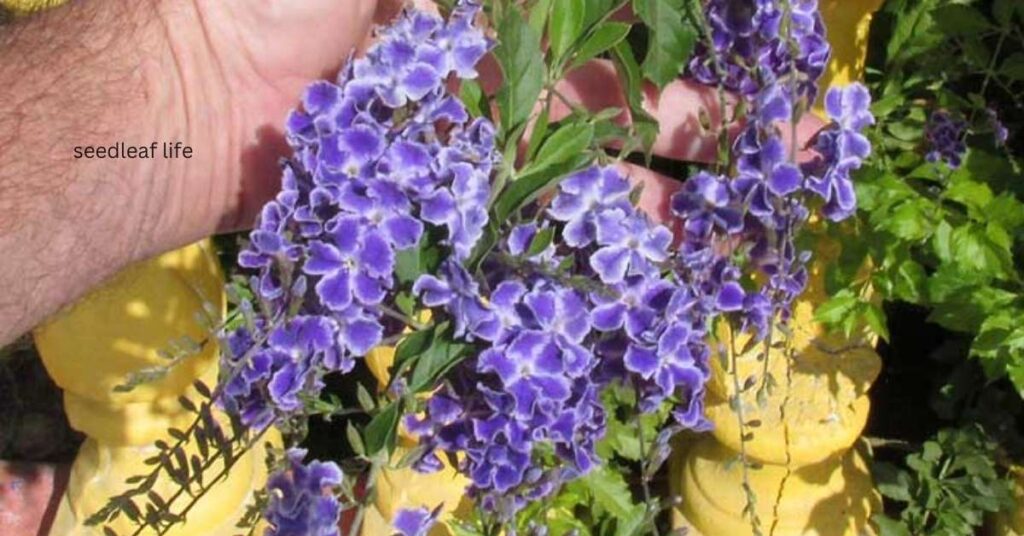
The Sky Flower Plant (Duranta erecta) is not limited to one part of the world—it is cultivated across continents due to its adaptability and striking appearance. From Asia’s tropical regions to the warm climates of the Americas and Australia, this ornamental shrub has found a home in gardens, public parks, and landscapes worldwide.
Sky Flower Plant in Asia
- Widely cultivated in India, Pakistan, Bangladesh, and Sri Lanka, where it thrives in tropical monsoon climates and is often grown as a natural hedge.
- In Thailand, Malaysia, Indonesia, and the Philippines, it is valued for decorative landscaping, temple courtyards, and city gardens.
- Increasingly planted in China and other South Asian regions as an ornamental shrub for both homes and public spaces.
Sky Flower Plant in the Americas
- Native to the Caribbean and South America, especially Brazil, Venezuela, and Colombia, where it grows naturally and decorates local gardens.
- Popular in Mexico, Central America, and the southern U.S. (Florida, Texas) as a flowering hedge that attracts hummingbirds and butterflies.
- Featured in botanical gardens across Latin America, adding ecological and ornamental value.
Sky Flower Plant in Africa and Australia
- Grown in South Africa, Kenya, and Tanzania, often used in coastal and dry regions as a hardy garden hedge.
- Widely planted in Australia’s Queensland and New South Wales, appearing in both residential yards and public parks.
- Appreciated in these regions for being drought-tolerant and adaptable to both semi-arid and tropical climates.
Conclusion
The Sky Flower Plant (Duranta erecta) is a stunning ornamental shrub known for its purple blooms, golden berries, and ability to attract pollinators. While it enhances gardens worldwide with beauty and versatility, its fruits are toxic, so care is needed around children and pets. With proper sunlight, watering, and pruning, this adaptable plant can thrive across tropical and subtropical regions, making it a favorite choice for gardeners everywhere.

